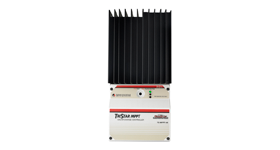Products -> Solar Charge Controllers > Morningstar > Morningstar Tristar MPPT
Tristar MPPT - charge controller
Solar Controller with maximum power point tracking
Morningstar's TriStar MPPT solar controller with TrakStar Technology™ is an advanced maximum power point tracking (MPPT) battery charger for off-grid photovoltaic (PV) systems up to 3kW. The controller provides the industry's highest peak efficiency of 99% and significantly less power loss compared to other MPPT controllers.
The TriStar MPPT features a smart tracking algorithm that maximizes the energy harvest from the PV by rapidly finding the solar array peak power point with extremely fast sweeping of the entire I-V curve. This product is the first PV controller to include on-board Ethernet for a fully web-enabled interface and includes up to 200 days of data logging.
Product features
- Maximizes energy harvest
- Extremely high reliability
- Every high efficiency
- Extensive networking and communications capabilities
- Metering and data loggin
- Solar : Overload, Short Circuit, High Voltage
- Battery : High Voltage
- High Temperature
- Lightning and Transient Surges
- Reverse Current at Night
General recommendations
Two criteria are decisive on charge controllers with MPP tracking: Firstly, the total output of all connected solar modules (in Wp) must not exceed the maximum input power of the solar charge controller. Secondly, the open circuit voltage (Uoc) on all solar modules (also series-connected) must not exceed the maximum input voltage of the solar charge controller under any circumstances. Care must be taken here, especially due to the temperature dependence of the open circuit voltage on the solar modules. This voltage increases as the temperature decreases. Based on the lowest temperature which occurs during the application, the open circuit voltage of the solar module must be calculated using the temperature coefficients from the module data sheet. The maximum input voltage of the solar charge controller must be higher than this voltage.
TrakStar MPPT Technology
The TriStar MPPT utilizes Morningstar's TrakStarTM Maximum Power Point Tracking technology to extract maximum power from the solar array. The tracking algorithm is fully automatic and does not require user adjustment. TrakStarTM technology tracks the array maximum power point as it varies with weather conditions, ensuring that maximum power is harvested from the array through the course of the day.
Under most conditions, TrakStarTM MPPT technology will "boost" the solar charge current. For example, a system may have 36 Amps of solar current fl owing into the TS-MPPT and 44 Amps of charge current fl owing out to the battery. The TriStar MPPT does not create current! Rest assured that the power into the TriStar MPPT is the same as the power out of the TriStar MPPT. Since power is the product of voltage and current (Volts x Amps), the following is true:
Power Into the TriStar MPPT = Power Out of the TriStar MPPT
Volts In x Amps In = Volts Out x Amps Out
If the solar module's maximum power voltage (Vmp) is greater than the battery voltage, it follows that the battery current must be proportionally greater than the solar input current so that input and output power are balanced. The greater the difference between the Vmp and battery voltage, the greater the current boost. Current boost can be substantial in systems where the solar array is of a higher nominal voltage than the battery as described in the next section.
High Voltage Strings and Grid-tie Modules
Another benefit of TrakStar MPPT technology is the ability to charge batteries with solar arrays of higher nominal voltages. For example, a 12 Volt battery bank may be charged with a 12-, 24-, 36-, or 48-Volt nominal off-grid solar array. Grid-tie solar modules may also be used as long as the solar array open circuit voltage (Voc) rating will not exceed the TriStar MPPT 150 Volt maximum input voltage rating at worst-case (coldest) module temperature. The solar module documentation should provide Voc vs. temperature data.
Higher solar input voltage results in lower solar input current for a given input power. High voltage solar input strings allow for smaller gauge solar wiring. This is especially helpful and economical for systems with long wiring runs between the controller and the solar array.
Conditions That Limit the Effectiveness of MPPT
The Vmp of a solar module decreases as the temperature of the module increases. In very hot weather, the Vmp may be close or even less than battery voltage. In this situation, there will be very little or no MPPT gain compared to traditional controllers. However, systems with modules of higher nominal voltage than the battery bank will always have an array Vmp greater than battery voltage. Additionally, the savings in wiring due to reduced solar current make MPPT worthwhile even in hot climates.



